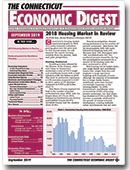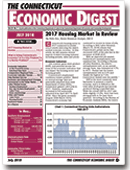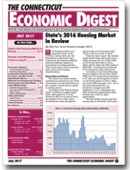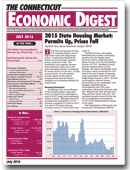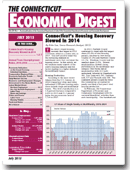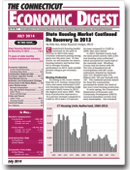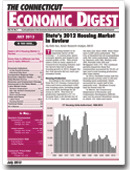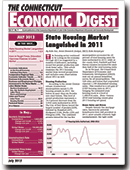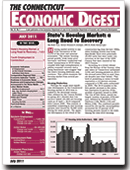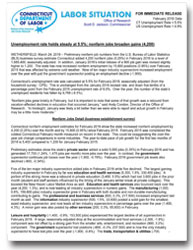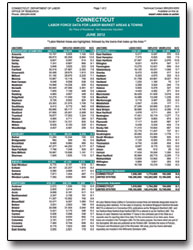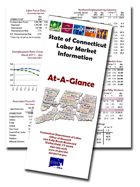Connecticut's Housing Market Trended Upward in 2019
By Kolie Sun Kolie.Sun@ct.gov, Senior Research Analyst, Department of Economic and Community Development
 onnecticut’s housing market showed signs of strength in 2019 as new permits reached their second highest level since 2007 and home sales prices reached an eleven-year high. This article examines several factors contributing to the state’s housing rebound.
onnecticut’s housing market showed signs of strength in 2019 as new permits reached their second highest level since 2007 and home sales prices reached an eleven-year high. This article examines several factors contributing to the state’s housing rebound.
Housing Production According to data release from the Bureau of the Census, cities and towns in Connecticut authorized 5,854 single and multifamily homes with a total valuation of $1.354 billion in 2019. The level of production is the highest since 2015 and represents a 21.6% increase compared to 4,815 in 2018. Connecticut had the third highest percent gain among fifty states: New Jersey and Arkansas led with 30.6% and 25.0%, respectively.
In 2019, Fairfield County authorized the most permits with the largest share (39.7%), followed by New Haven County (24.8%) and Hartford County (13.5%). Both Litchfield and Middlesex counties had the smallest share (2.3%). Stamford, New Haven, Fairfield, Milford and Norwalk issued the most permits. Combined, they accounted for 42% of all housing units authorized last year.
The multifamily sector played an integral role in Connecticut’s strong performance in 2019, with over half of the state’s units (from percentage perspective) coming from 5-unit or more structures. In fact, Connecticut ranked 4th in the nation in multifamily authorization.
The demand for multifamily units gained momentum over the past decade. More than 49K total housing units were authorized in Connecticut between 2010 and 2019. Single family homes accounted for 51% of housing production while multifamily (5-unit or more) homes accounted for 44%. This is a contrast compared to the prior decade (2000-2009) when more than 77% of new housing units were in single family homes and 19% in multifamily. The shift of housing choices can be partially attributed to the growth of transit-oriented development, creating walkable urban environments that are seen as increasingly attractive to millennials and baby boomers.
The Department of Economic and Community Development (DECD) annually surveys each municipality for demolition information. One hundred twenty-two towns responded (72.2% response rate), reporting 828 demolished units last year. As a result, the state’s net gain of 5,026 units brings its housing inventory estimates to 1,522,681 units.
The Economy Many economic indicators have direct impact on the housing market. Gross Domestic Product (GDP), personal income and employment are just a few.
Since 2010, the U.S. economy, based on real gross domestic product (RGDP)1, the most common barometer to gauge the health of economy, has grown at an average annual growth rate (AAGR) of 2.3%, while the state’s economic growth was near zero. This means that Connecticut’s economy in 2019 was about the same size it was ten years ago. For year over year comparison, state’s economy grew 1.6% over 2018, the second highest growth since 2008; while the nation had a 2.3% increase.2
Consumer spending is a function of income. Higher disposable income, income after tax, implies stronger growth in consumer spending that can lead to a stronger economy. In 2019, Connecticut’s personal income increased 3.2% while the U.S. experienced a 4.4% gain according to estimates from the Bureau of Economic Analysis (BEA). During the past decade, nation’s personal income grew at a faster pace than the state. Based on AAGR, personal income in U.S. increased 4.5% annually while Connecticut had a 2.7% gain. However, Connecticut’s per capita income remains the highest in the nation, at $79,087.
Connecticut saw the first employment decline since the great recession ended in 2010. Based on annual average data, not seasonally adjusted, from the state Department of Labor (DOL), state lost 3,300 (-0.2%) jobs in 2019, compared to a gain of 2,600 (0.2%) in 2018. U.S. employment grew 1.4% and 1.6% in 2019 and 2018, respectively.
Connecticut’s unemployment rate continued to fall in 2019, following the national trend. According to Bureau of Labor Statistics, the state’s annual average unemployment rate was estimated at 3.7% in 2019, the lowest level since 2001. From the same source, the U.S. unemployment rate fell two-tenths of a percent to 3.7% from 2018 level.
Home Sales and Prices With an improved economy, strong consumer confidence and a decade low unemployment rate in 2019, Connecticut’s real estate market had a strong performance as home prices rose to an eleven-year high.
According to the Warren Group report, Connecticut’s median single-family sale price reached $260,000, a 0.4% increase from 2018. Although it achieved an 11-year high last year, it still is almost 12% below the peak value of $295,000 in 2007. The median sale price for condominium reached $167,000, a 1.2% increase over 2018 and a five-year high.
From the same source, Connecticut’s single-family home sales totaled 33,146 in 2019, although it represented a 2.1% decrease from the previous year, but higher than 32,272 in 2007. Condominium sales did better with a gain of 0.2% over 2018.
Real estate markets vary from region to region. Fairfield County saw a modest 1% increase in unit sales, while the Connecticut shoreline saw unit sales and dollar volume stabilized. Litchfield County experienced dollar volume growth and the Farmington Valley was flat with steady sales.3
According to the Federal Housing Financing Agency’s Home Price Index (HPI),4 U.S. house prices advanced 5.1% from the fourth quarter of 2018 to the fourth quarter of 2019. The HPI ranges from the highest annual appreciation in Idaho (12.0%) to the smallest in Connecticut (1.9%). For a five-year period (Q4:2014 to Q4:2019), Connecticut’s HPI registered at 9.9%, compared to 32.9% at U.S. level, indicating very little home price appreciation.
Mortgage rates were at historic lows in 2019. Interest rates have a direct effect on consumer behavior, affecting many aspects of daily life. When rates go down, borrowing becomes cheaper, making home, auto and other purchases more affordable. Mortgage rates lowered as a result of the Fed’s rate cuts three times in 2019. According to Freddie Mac, the conventional 30-year mortgage rate on an annual average basis, was 3.94% last year, down from 4.54% in 2018, and 3.99% in 2017.
Homeownership Homeownership has always been the cornerstone of the American dream. Many benefits for being homeowners include emotional and financial stability, and boost household equity and appreciation over time.
Connecticut’s homeownership rate has been generally higher than the nation. Connecticut’s homeownership rate peaked at 73.0% in 2003, while the U.S. peaked a year later at 69.0%. In 2019, homeownership rates in U.S. and Connecticut registered at 64.6% and 64.3%, respectively.5
On average, Litchfield County homeownership rate (81.4%) ranked the highest, followed by Middlesex County (79.3%), Tolland County (78.9%), and New Haven County the lowest (67.6%).6
Looking Forward Connecticut’s housing market experienced robust growth in 2019, but the onset of the COVID-19 pandemic casts doubt on this trend continuing in 2020.
According to the forecast from National Association of Realtors (NAR), home sales will drop 13.5% this year. Prior to the pandemic, the organization forecasted a 3% increase. Many experts believe that prices will be relatively flat for the rest of the year. NAR projected a 1% increase in 2020. Lawrence Yun, NAR’s Chief Economist, said, “As the economy steadily re-opens and people feel more comfortable about social distancing activities, home buying should normalize.”7
It is worth noting that segments of Connecticut’s real estate market could realize gains as some choose to vacate high-density environments like New York City. There have been several media reports about this behavioral change. For example, Carissa McMahon, partner at Carissa & Douglas Properties and Coldwell Banker Global Luxury Specialist, made the following observation in May: “90% of our showings this month have been to clients planning a move out of the city.”8 How this might impact Connecticut’s housing market won’t be known until this year’s housing data is compiled.
 Real Gross Domestic Product: the constant dollar value of all final goods and serviced produced in the U.S.
Real Gross Domestic Product: the constant dollar value of all final goods and serviced produced in the U.S.
 Data source: Bureau of Economic Analysis; DECD calculations
Data source: Bureau of Economic Analysis; DECD calculations
 2019 Year in Review Market Watch, William Pitt-Julia B. Fee, Sotheby’s International Realty
2019 Year in Review Market Watch, William Pitt-Julia B. Fee, Sotheby’s International Realty
 Federal Housing Financing Agency, Quarterly Data: Purchase-Only Indexes
Federal Housing Financing Agency, Quarterly Data: Purchase-Only Indexes
 Federal Reserve Bank of St. Louis: Homeownership Rate for the United States and Connecticut, Percent, Annual, Not Seasonally Adjusted
Federal Reserve Bank of St. Louis: Homeownership Rate for the United States and Connecticut, Percent, Annual, Not Seasonally Adjusted
 Federal Reserve Bank of St. Louis: Homeownership Rate (5-year estimate) for all counties in CT, Rate, Annual, Not Seasonally Adjusted, 2009-2018
Federal Reserve Bank of St. Louis: Homeownership Rate (5-year estimate) for all counties in CT, Rate, Annual, Not Seasonally Adjusted, 2009-2018
 https://therealdeal.com/2020/04/29/nar-predicts-home-sales-to-drop-10-in-2020/
https://therealdeal.com/2020/04/29/nar-predicts-home-sales-to-drop-10-in-2020/
 https://www.prnewswire.com/news-releases/the-real-estate-space-race-will-connecticut-win-the-monopoly-on-nyc-301057563.html
https://www.prnewswire.com/news-releases/the-real-estate-space-race-will-connecticut-win-the-monopoly-on-nyc-301057563.html
 |



















